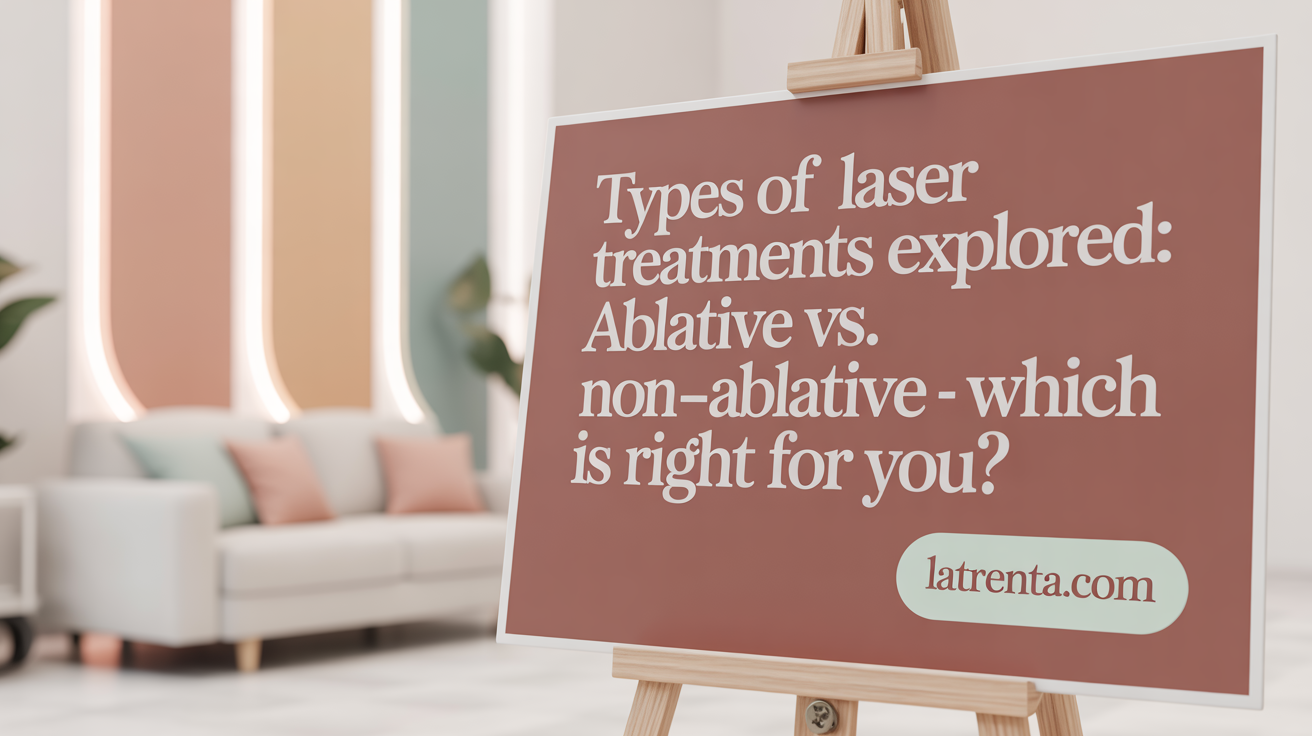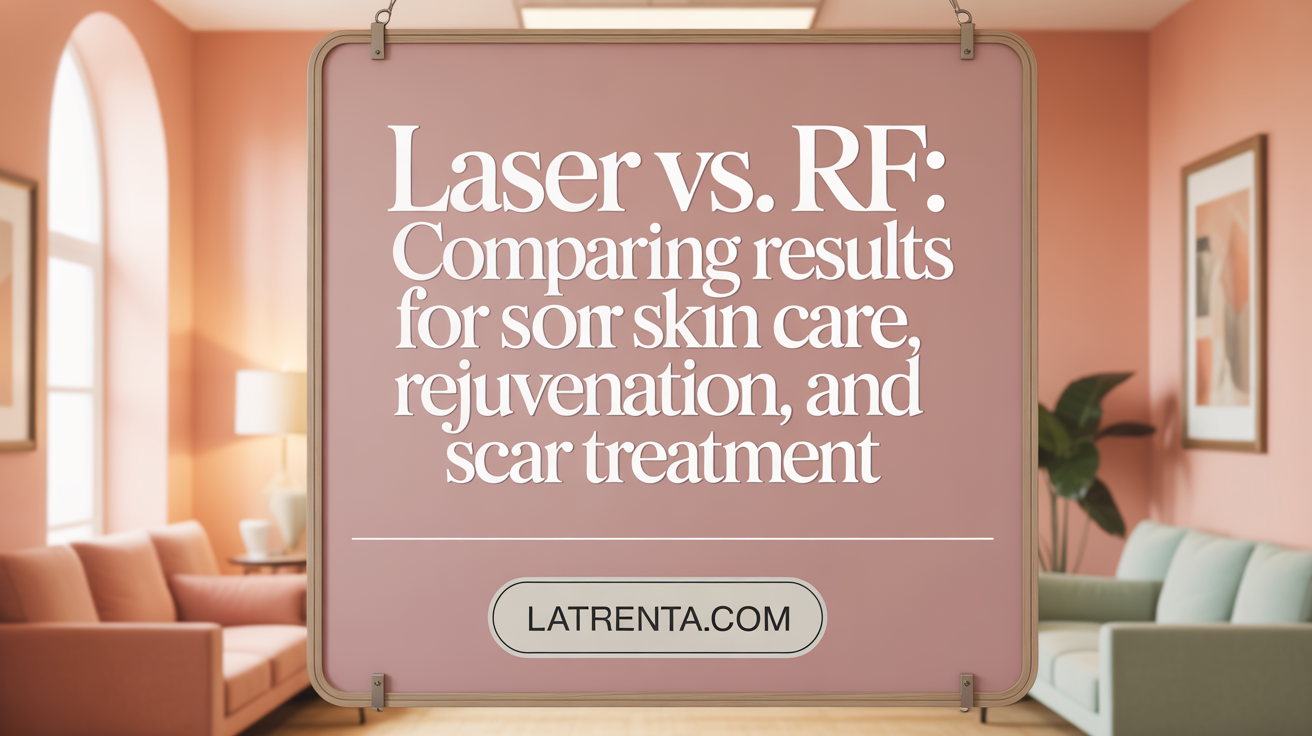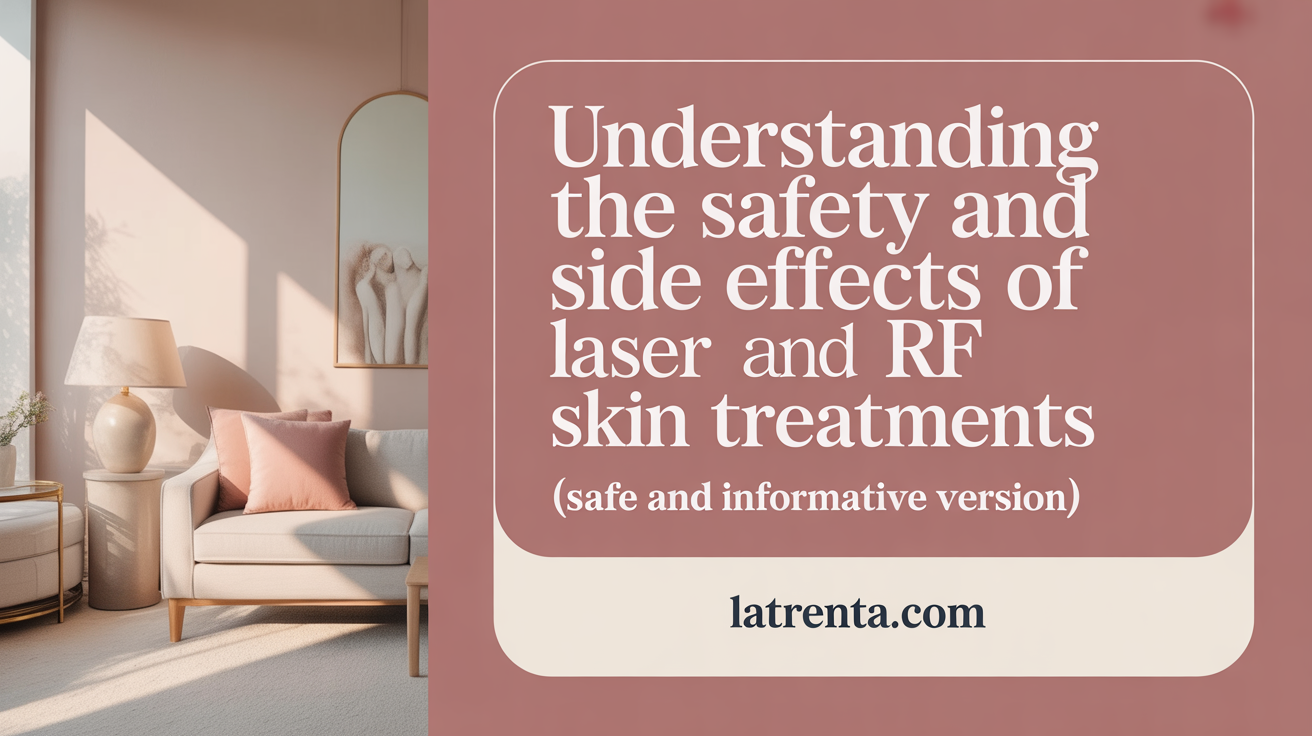Understanding Your Skin Treatment Options
Choosing the right skin treatment can be challenging, especially with the array of advanced technologies available today. Two of the most popular non-invasive methods, laser and radiofrequency (RF) treatments, offer distinct approaches to rejuvenating and tightening skin. This guide breaks down the advantages and disadvantages of each to help you make an informed decision tailored to your skin goals and concerns.
Laser and RF Skin Treatments Key Facts
- Laser treatments utilize focused light beams to target specific skin concerns, including pigmentation, scars, and wrinkles.
- Laser devices are classified as ablative, which remove outer skin layers, or non-ablative, which heat underlying tissue without removing surface skin.
- Laser treatments can stimulate collagen production, leading to tightening and rejuvenation of the skin over multiple sessions.
- Typical downtime post-laser ranges from a few days (non-ablative) to 7-10 days (ablative), with side effects like redness and peeling.
- RF treatments use electromagnetic waves to heat deeper skin layers, stimulating collagen and leading to skin tightening and wrinkle reduction.
- RF is safe for all skin tones because it doesn't rely on melanin absorption, unlike some laser therapies which risk pigmentation issues in darker skin.
- Combined laser and RF treatments can synergistically improve skin texture, firmness, and overall rejuvenation, often with personalized treatment plans.
- Common side effects of laser include irritation, hyperpigmentation, and hypopigmentation, requiring experienced practitioners for safety.
- RF treatments typically involve minimal downtime and mild side effects, making them suitable for busy schedules and darker skin types.
- Comprehensive skin improvement often involves multiple sessions; consultation with a certified specialist ensures safe and effective treatment selection.
1. Laser Treatments: Advantages and Limitations

How do laser treatments work?
Laser treatments use highly focused beams of light energy to target specific skin concerns. Depending on the wavelength, lasers can remove damaged skin layers, stimulate collagen production, or target particular pigmentation or blood vessels.
What skin concerns do laser treatments address?
Laser therapy effectively treats a variety of skin issues including fine lines, wrinkles, sun spots, age spots, scars from acne or surgery, uneven skin tone, pigmented lesions, and unwanted hair. The precision and strength of laser energy help improve both skin texture and appearance.
What are the types of lasers used?
Laser devices are classified as ablative or non-ablative. Ablative lasers, like CO2 and Erbium lasers, remove the outer layer of skin to promote powerful collagen regeneration, suitable for deep rejuvenation. Non-ablative lasers, such as Fraxel and Clear + Brilliant, heat the underlying tissue without removing surface skin, offering lighter rejuvenation with less recovery time.
How effective are laser treatments for skin tightening and rejuvenation?
Laser therapy can stimulate collagen production, leading to tighter, smoother skin. Fractional laser treatments create microscopic columns of treated tissue, encouraging rapid healing and collagen build-up, which improves skin elasticity and firmness over multiple sessions.
What is the typical downtime and potential side effects?
Post-treatment recovery varies by laser type. Ablative procedures often require 7-10 days of healing, during which swelling, redness, and peeling are common. Non-ablative treatments have minimal downtime, with temporary redness and swelling. Side effects include skin inflammation, itching, pain, and, rarely, infection or pigment changes.
Is laser treatment suitable for all skin tones?
Laser treatments are generally safe for lighter to medium skin tones, but darker skin may face higher risks of pigmentation changes or scarring. Specific laser types, such as Nd:YAG, are better suited for darker skin. Consultation with a specialist ensures appropriate selection.
How many sessions are needed, and what's the recovery timeline?
Most laser treatments require multiple sessions—typically 4 to 6 spaced 4-6 weeks apart—to achieve optimal results. Recovery time can vary; non-ablative lasers often require only a few days of downtime, while ablative lasers may necessitate a week or more of healing.
What are the fundamental differences between laser and radiofrequency (RF) treatments?
Laser and RF treatments differ mainly in how they deliver energy. Lasers use concentrated light to target specific skin issues with high precision, affecting surface or deeper layers depending on the type. RF uses electromagnetic waves to penetrate deeper into the dermis, heating tissue to stimulate collagen without affecting the skin surface.
Both methods are effective for skin rejuvenation but serve different purposes. Lasers are more suitable for superficial concerns like pigmentation and scars, while RF is often chosen for skin tightening and gradual wrinkle reduction. Safety and efficacy depend on the treatment area, skin type, and provider expertise.
2. Radiofrequency Treatments: Benefits and Drawbacks
What is the operational principle of RF treatments?
Radiofrequency (RF) treatments use electromagnetic waves to generate heat within the deeper layers of the skin. Devices typically operate at frequencies between 0.3 to 10 MHz, allowing them to safely penetrate without damaging the skin’s surface. When the RF energy heats the dermis, it causes collagen fibers to contract and stimulates the production of new collagen and elastin, essential proteins for maintaining skin firmness and elasticity.
How effective are RF treatments for collagen stimulation and skin tightening?
RF therapy is highly valued for its ability to promote collagen remodeling, resulting in gradual skin tightening, wrinkle reduction, and improved skin texture. The heat stimulates fibroblasts—cells responsible for collagen production—leading to firmer, more elastic skin over time. While results vary depending on individual skin conditions, RF treatments generally deliver visible improvements within two to six months after multiple sessions.
What is the safety profile of RF treatments across different skin tones?
One of the main advantages of RF technology is its safety across a wide range of skin tones. Unlike some laser treatments that target pigment and may risk hyperpigmentation or hypopigmentation, RF machines are 'color-blind,' meaning they do not rely on melanin absorption. This makes RF a suitable choice for darker skin types, including those with higher melanin levels, reducing the risk of pigment-related side effects.
What are common side effects and how can they be managed?
RF treatments are generally well-tolerated, with most patients experiencing mild redness, swelling, or tingling that subsides within hours to a day. Slight discomfort during treatment is common but can often be alleviated with cooling measures or topical anesthetics. Rare risks include burns or crusting if the device is used improperly, emphasizing the importance of selecting a skilled practitioner. Proper post-treatment care, including sun protection and moisturizing, helps mitigate adverse effects.
How often are sessions required, and how long do results last?
Most patients undergo a series of 3 to 6 sessions spaced about 2 to 4 weeks apart for optimal results. The effects of skin tightening and collagen regeneration develop gradually and continue over several months. Maintenance sessions may be needed annually to sustain the results. Typically, the benefits last from one to three years, depending on individual aging processes and skin care routines.
What is RF microneedling and how does it serve as a hybrid option?
RF microneedling combines the technology of tiny, sterile needles with RF energy to deliver heat deep into the skin. This hybrid approach enhances collagen production while minimizing surface damage, making it effective for deeper scars, fine lines, and skin laxity. RF microneedling is often more tolerable than traditional microneedling or laser procedures and leaves the epidermis intact, reducing risks of scarring and infection.
What should patients expect regarding downtime and comfort?
The procedure typically involves minimal downtime—patients may experience mild redness and swelling lasting 1-4 days. Discomfort varies; some report a sensation of warmth or slight pinching, which can be managed with cooling or topical anesthesia. Because RF treatments are non-invasive and produce gradual improvements, most patients can return to daily activities immediately after, making them an accessible option for busy schedules.
Comparing Outcomes of Laser and RF Treatments for Skin Concerns

How do laser and RF treatments compare in outcomes for skin tightening, rejuvenation, and scar removal?
Laser and radiofrequency (RF) treatments are both popular non-invasive options for improving skin appearance, but they differ in how they achieve results and their safety profiles. Understanding these differences helps patients choose the best treatment for their specific skin concerns.
Laser treatments use concentrated light energy to target specific issues like pigmentation, sun damage, and scars. This precise targeting allows for effective removal of damaged skin cells and the stimulation of collagen production at or near the surface, which results in smoother, more even skin. Types such as ablative lasers remove the outer layers for deeper rejuvenation but require longer recovery times, whereas non-ablative lasers produce subtler results with shorter healing periods. Laser therapy excels in improving surface irregularities, reducing fine lines, and addressing pigmentary discoloration.
Radiofrequency (RF) treatments work by delivering electromagnetic waves into the deeper dermal layers, heating tissues to stimulate collagen and elastin production. This collagen remodeling results in skin tightening and improved elasticity, often with fewer side effects related to surface damage. RF is particularly effective for addressing skin laxity, reducing wrinkles, and tightening tissues without removing skin or causing significant pigmentation changes.
In terms of scar removal, laser treatments are highly effective on superficial scars and pigmentation issues. Ablative lasers can significantly diminish surface scars but involve longer downtime and a higher risk of side effects. RF microneedling, which combines tiny needles with RF energy, can reach deeper into the skin to improve scars with minimal downtime and lower risk of pigmentation changes, making it suitable for a variety of skin types.
The recovery profiles also differ: laser treatments often entail longer healing periods, especially for ablative procedures, and carry higher risks of side effects such as redness, swelling, or pigmentation issues. Conversely, RF treatments typically involve minimal discomfort, faster recovery, and less risk of surface irritation.
Long-term results from both treatments tend to be comparable, with improvements lasting from one to three years, provided patients maintain proper skin care and sun protection. The ideal choice depends on individual skin concerns, desired downtime, and treatment tolerance.
| Treatment Aspect | Laser Therapy | RF Therapy | Additional Notes |
|---|---|---|---|
| Targets | Surface pigmentation, irregularities, scars | Deep collagen remodeling, skin tightening | Laser offers precise surface targeting |
| Main Benefits | Surface rejuvenation, scar reduction, pigment correction | Skin tightening, wrinkle reduction, collagen boost | RF is less invasive with quicker recovery |
| Recovery Time | 1-2 weeks (ablative), days (non-ablative) | 1-4 days | Laser often involves more downtime |
| Skin Types | Fair to tan skin, limited for darker skin | Safer for all skin tones | RF has a broader safety profile |
| Suitable For | Surface and superficial scars, pigment issues | Lax skin, deep scars, collagen deficiency | Combines well with other treatments for enhanced results |
Both laser and RF treatments offer significant benefits, but choosing the right method depends on the specific skin issues, acceptance of downtime, and risk tolerance. Consulting with a licensed specialist will ensure a tailored approach that optimizes outcomes and safety.
Safety Profiles and Side Effects of Laser and Radiofrequency Treatments

What are the common side effects or drawbacks associated with laser therapy for skin treatments?
Laser therapy, while highly effective for various skin concerns, has associated risks and potential side effects. Common issues include skin irritation such as swelling, redness, itching, and prolonged erythema that may last several days after treatment. In some cases, more serious complications can occur, including burns, scarring, infections, hyperpigmentation, hypopigmentation, and contact dermatitis, especially if the procedure isn't performed properly. Certain treatments may lead to the development of milia, or tiny cysts, and some patients experience transient acne outbreaks. There is also a risk of ophthalmic injuries if eye protection isn't correctly used during procedures near the eyes. Because laser energy targets specific skin components, uneven results and unpredictable responses can happen, particularly in individuals with darker skin tones or certain medical histories. Overall, although laser therapies are generally safe when administered by experienced professionals, the risk of adverse effects underscores the need for careful case evaluation and professional oversight.
What are the benefits and drawbacks of radiofrequency (RF) skin treatments?
Radiofrequency (RF) treatments provide a non-invasive option for skin tightening and rejuvenation. The advantages include minimal downtime, making them convenient for patients with busy schedules. RF devices typically have a good safety profile, especially when performed by qualified practitioners, and can be used across a wide range of skin tones without the risk of pigmentation issues, unlike some laser procedures. RF treatments work by heating the dermal layers to stimulate collagen and elastin production, encouraging skin tightening and reduced wrinkles over time. Patients often see gradual improvements, with results lasting from one to three years with proper maintenance. They usually experience only mild side effects, such as temporary redness, swelling, tingling, or sensation of heat, which resolve quickly. However, some drawbacks include the need for multiple sessions to achieve noticeable results. There is also a small risk of side effects like burns if the device isn't correctly used or if the treatment is overdone. Occasionally, patients report discomfort or a sensation of warmth during sessions. While RF treatments are safe, overexposure or poor technique can lead to burns, crusting, or pigment changes. Overall, RF premium benefits in safety and minimal recovery make it an attractive option for many, but it may not deliver instant or dramatic results compared to surgical options.
Suitability and Considerations for Choosing Between Laser and RF
When individuals are exploring skin tightening and rejuvenation options, understanding the differences between laser and radiofrequency (RF) treatments is essential. The decision depends on several factors, including skin type, treatment goals, and the chance for downtime.
What factors should individuals consider to make an informed decision between laser and RF skin treatments?
One of the primary considerations is skin type and tone. Lasers are highly specific and often more effective on lighter or tanned skin, targeting issues like pigmentation, sun damage, and surface scars. In contrast, RF treatments are generally 'color-blind,' making them safer for darker skin tones and those with more melanin, as they do not significantly heat pigmented cells.
Next, personal treatment goals should be evaluated. Laser treatments excel at addressing pigmentation, fine lines, wrinkles, and superficial skin concerns. They produce noticeable results more quickly but may require longer recovery times. RF therapies, including radiofrequency microneedling like Thermage® and Morpheus8, stimulate collagen production deeply within the skin, effectively improving skin laxity, wrinkles, and overall texture over time with minimal downtime.
Downtime tolerance and recovery are also important. Laser procedures, particularly ablative types, often involve several days of healing and increased risk of side effects such as redness, swelling, or pigmentation changes. RF treatments tend to have shorter recovery periods—often just a few days—making them more appealing to those with busy schedules.
Cost and the number of treatments needed should also influence the choice. Laser treatments, especially deep resurfacing procedures, can be more expensive per session and often require multiple treatments for optimal results. RF therapies are generally less costly and may need fewer sessions for similar outcomes, though results develop gradually.
Finally, consulting with experienced professionals is vital. A licensed dermatologist or cosmetic surgeon can assess individual skin characteristics, discuss goals, and recommend the most suitable approach—whether laser, RF, or a combination of both. Personalized plans ensure effective and safe results.
Choosing the right treatment involves weighing these considerations carefully. By evaluating skin type, target concerns, recovery needs, and costs, patients can work with their providers to select the most appropriate and effective skin rejuvenation method for their unique situation.
Benefits of Combined Laser and RF Treatment Approaches

Are combined or sequential uses of laser and RF treatments beneficial for skin care?
Combining laser and radiofrequency (RF) treatments can provide enhanced results by targeting different skin concerns simultaneously. Laser therapy excels at addressing surface issues like pigmentation, scars, and fine lines, delivering quick and noticeable improvements.
RF treatments, through deep heat stimulation, promote collagen and elastin production, which leads to skin tightening, increased elasticity, and longer-lasting rejuvenation.
When used together, or in sequential sessions, these modalities can work synergistically to improve overall skin texture, firmness, and rejuvenation. This integrated approach allows for precise correction of superficial skin problems while boosting deeper tissue health.
Personalized treatment plans are crucial. A qualified professional will assess your skin type, concerns, and goals to determine the best combination and order of treatments.
This strategy often results in more comprehensive skin improvements than either treatment alone, minimizing the need for invasive procedures.
However, it is essential to consult with experienced specialists who can tailor therapies to your individual needs, ensuring safe and effective outcomes.
Treatment sequencing and personalization
The optimal sequence depends on the specific skin issues being addressed. Typically, laser treatments can be performed first for surface refinement, followed by RF for deeper rejuvenation. Alternatively, some patients may benefit from combined sessions from the outset.
Personalization includes adjusting settings, number of sessions, and interval timing to maximize benefits and minimize risks.
Improved skin texture, firmness, and rejuvenation
The combined approach enhances skin texture by smoothing irregularities and improving tone. It also boosts skin firmness and elasticity, reducing sagging and fine lines.
Long-term benefits include a more youthful appearance, with results often lasting over a year or more with proper skincare and maintenance.
Ideal candidates for combination therapies
Candidates are generally those seeking non-invasive solutions for aging, uneven pigmentation, scars, or loss of skin firmness.
Good candidates include patients with mild to moderate skin laxity, sun damage, or scars that do not want surgery.
Individuals with darker skin tones can especially benefit from RF, as it poses less risk of pigmentation changes compared to some laser treatments.
Always undergo a thorough consultation to ensure suitability and to develop a tailored, safe treatment plan that addresses your unique skin concerns.
Making the Right Choice for Your Skin
Understanding the distinct advantages and limitations of laser and radiofrequency treatments empowers you to select the most suitable path for your skin rejuvenation goals. While laser therapies offer precision and effectiveness for surface concerns such as pigmentation, scars, and textural irregularities, they often require longer recovery and present a higher risk of side effects. Radiofrequency treatments provide a gentler, deeper approach to collagen stimulation and skin tightening, suitable for a broader range of skin tones with minimal downtime. Combining both technologies can further enhance results by addressing multiple layers and issues simultaneously. Ultimately, consulting experienced professionals to tailor treatments based on your skin type, concerns, and lifestyle ensures safe, effective, and satisfying outcomes.
References
- Radiofrequency vs. Laser Treatments: The Pros & Cons of Each
- Radiofrequency vs Laser Skin Tightening | BBL, Morpheus8 ...
- RF Microneedling vs Laser Treatment - University Park Dermatology
- Advantages of RF Microneedling vs. Laser Scar Removal
- Microneedling vs Laser: Why It's Better to Do These Treatments ...
- Radio Frequency vs. Other Skin Tightening Treatments - Lucsuer
- So, Are Radiofrequency Treatments Really Safe?
- Laser vs RF Microneedling - Aglow Dermatology
